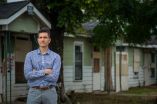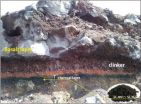(Press-News.org) Playing in schoolyards that feature natural habitats and trees and not just asphalt and recreation equipment reduces children's stress and inattention, according to a University of Colorado Boulder study.
Working on class assignments or gardening in such settings also provide stress-reducing benefits for youth, according to a paper published in the journal Health & Place. The study is one of the first of its kind to focus on the relationship between student access to green settings and stress.
"Many schools already offer stress management programs, but they're about teaching individuals how to deal with stress instead of creating stress-reducing environments," said Louise Chawla, CU-Boulder professor of environmental design and lead author of the study. "Schools are where children spend a major part of their life hours, so it's an important place to look at for integrating daily contact with the natural world because of the many benefits it brings."
Natural-terrain schoolyards -- with dirt, scrub oak and water features, for example -- foster supportive relationships and feelings of competence, the researchers found.
Combination schoolyards that have at least some natural-habitat landscaping, even if they include built structures as well, can have positive impacts on children, said Chawla, who also is the director of CU-Boulder's Children, Youth and Environments Center.
Co-authors of the paper included three former doctoral students: Kelly Keena and Illène Pevec, both who were at the University of Colorado Denver; and Emily Stanley, who was at Antioch University New England in Keene, N.H.
For the study, a variety of settings were observed including elementary-school students' recess in wooded and built areas; fourth- through sixth-grade students' use of a natural habitat for science and writing lessons; and high school students' gardening for volunteerism, required school service or coursework.
The sites were located at a private elementary school in Baltimore that serves children with dyslexia and other learning disabilities; a public elementary school in suburban Denver with students from a range of socioeconomic backgrounds; and four public and private entities for teenagers -- a college preparatory school, a public high school, an alternative school and an afterschool program -- throughout Colorado.
Together the researchers logged more than 1,200 hours of observation. They interviewed students, teachers, parents and alumni and coded keywords from the interviews for their findings, among other methods.
Over three school years at the Baltimore elementary school recess site, 96 percent of students in the first through fourth grades chose to play in the woods when they had the option of heading either there, to a playground or to an athletic field. In the woods, the younger children freely engaged in exploratory and sensory-based activities. The older children cooperatively organized activities like building forts and trading found objects.
Teachers at the Baltimore elementary school reported that the students returned from recess with longer attention spans. Some parents said the experience was empowering and critical to their child's well-being and social and emotional balance.
Students at the Denver elementary school, who completed assignments in a natural habitat, found the process to be an escape from stress in the classroom and at home, according to the study. Twenty-five percent of the students spontaneously described the green area as "peaceful" or "calm."
There also were anecdotal observations at the Denver school. In one case for example, a group of menacing schoolmates were unable to provoke a student in the green space whose temper normally was quick to escalate, according to the author.
"In more than 700 hours of observations at the Denver school's green outdoor space, zero uncivil behaviors were observed," said Chawla. "But there were many incidences of arguments and rudeness indoors, as there are at many schools."
Among the teenage participants throughout Colorado who gardened, 46 percent referred to calm, peace and relaxation in addition to other positive descriptors when reflecting on their experiences. They also gave four main reasons for their favorable reactions: being outdoors in fresh air; feeling connected to a natural living system; successfully caring for living things; and having time for quiet self-reflection.
For schools that are interested in providing natural habitats for students but only have built outdoor spaces, Chawla suggests tearing out some areas of asphalt or creating joint-use agreements with city parks and open space.
"Schools are really prime sites for an ecological model of health and for building access to nature into part of the school routine as a health measure," said Chawla.
INFORMATION: END
Natural-terrain schoolyards reduce children's stress, says Colorado University-Boulder study
2014-07-22
ELSE PRESS RELEASES FROM THIS DATE:
African-American homeownership increasingly less stable and more risky
2014-07-22
While historical barriers that excluded Black America from the homeowner market for decades have crumbled, there are signs that emerging types of racial inequality are making homeownership an increasingly risky investment for African-American home seekers. A new study from sociologists at Rice University and Cornell University found that African-Americans are 45 percent more likely than whites to switch from owning their homes to renting them.
The study, "Emerging Forms of Racial Inequality in Homeownership Exit, 1968-2009," examines racial inequality in transitions out ...
Low strength brain stimulation may be effective for depression
2014-07-22
Philadelphia, PA -- Brain stimulation treatments, like electroconvulsive therapy (ECT) and transcranial magnetic stimulation (TMS), are often effective for the treatment of depression. Like antidepressant medications, however, they typically have a delayed onset. For example, a patient may receive several weeks of regular ECT treatments before a full response is achieved.
Thus, there is an impetus to develop antidepressant treatments that act to rapidly improve mood.
Low field magnetic stimulation (LFMS) is one such potential new treatment with rapid mood-elevating ...
Boosting the force of empty space
2014-07-22
This news release is available in German.
Vacuum is not as empty as one might think. In fact, empty space is a bubbling soup of various virtual particles popping in and out of existence – a phenomenon called "vacuum fluctuations". Usually, such extremely short-lived particles remain completely unnoticed, but in certain cases vacuum forces can have a measurable effect. A team of researchers from the Weizmann Institute of Science (Rehovot, Israel) and the Vienna University of Technology has now proposed a method of amplifying these forces by several orders of magnitude ...
Anti-cancer drug kicks HIV out of hiding
2014-07-22
A pilot study by HIV researchers from Aarhus University and Aarhus University Hospital in Denmark has shown that an anti-cancer drug can activate hidden HIV. The researchers found that the anti-cancer drug romidepsin increased the virus production in HIV-infected cells between 2.1 and 3.9 times above normal and that the viral load in the blood increased to measurable levels in five out of six patients with HIV infection.
A pilot study
The results were presented today as breaking news at the annual international AIDS conference in Melbourne, Australia. The pilot study ...
Jeju Island is a live volcano
2014-07-22
In Jeju, a place emerging as a world-famous vacation spot with natural tourism resources, a recent study revealed a volcanic eruption occurred on the island. The Korea Institute of Geoscience and Mineral Resources (KIGAM) indicated that there are the traces that indicated that a recent volcanic eruption was evident 5,000 years ago. That is the first time to actually find out the date when lava spewed out of a volcano 5,000 years ago in the inland part of the island as well as the one the whole peninsula.
The research team led by Dr. Jin-Young Lee confirmed in results ...
Unique study focuses on combined treatment approach for locally advanced pancreatic cancer
2014-07-22
LOS ANGELES (July 21, 2014) – Investigators at the Cedars-Sinai Samuel Oschin Comprehensive Cancer Institute are developing a novel, multistep investigational treatment for one of the most complex and difficult-to-treat forms of the disease, locally advanced pancreatic cancer.
Locally advanced pancreatic cancer has the lowest survival rate of any solid tumor, with a cumulative five-year survival rate of only 4 percent for all stages of disease. Surgery is rarely an option for patients because tumors often involve vital blood vessels. Chemotherapy and radiotherapy given ...
Vanderbilt discovery may advance colorectal cancer diagnosis and treatment
2014-07-22
A Vanderbilt University-led research team has identified protein "signatures" of genetic mutations that drive colorectal cancer, the nation's second leading cause of cancer deaths after lung cancer.
The technological tour de force, described in the current issue of the journal Nature as the first integrated "proteogenomic" characterization of human cancer, "will enable new advances" in diagnosing and treating the disease, the scientists concluded.
"It's a first-of-its-kind paper. I think it's a very important advance in the field," said senior author Daniel Liebler, ...
Low-income students in charter high schools less likely to engage in risky behavior
2014-07-22
A new UCLA-led study suggests that a higher quality educational environment may help improve health outcomes
Low-income minority adolescents who were admitted to high-performing public charter high schools in Los Angeles were significantly less likely to engage in risky health behaviors than their peers who were not admitted to those schools, according to a new UCLA-led study.
These students also scored significantly better on California state standardized math and English tests.
While numerous previous studies have shown a link between health and K-12 education, ...
Strategies to preserve myelin during secondary degeneration following neurotrauma
2014-07-22
Researchers at the University of Western Australia, led by Associate Professor Melinda Fitzgerald, have discovered that preventing abnormalities in the insulating sheath surrounding nerve cells is associated with better function following neurotrauma.
Following injury to the central nervous system, damage spreads away from the initial impact in a process known as secondary degeneration. Dr Fitzgerald emphasises that "In order to develop treatments for secondary degeneration, we need to understand the biochemical reactions that occur in tissue that succumbs to spreading ...
Ginkgo biloba enhances neurogenesis and improves recovery following a stroke in mice
2014-07-22
Led by Dr. Zahoor A. Shah, Dr. Shadia E. Nada and Jatin Tulsulkar (graduate student), researchers at the University of Toledo, Toledo, OH, have discovered that mice treated with Ginkgo biloba 4 hours after inducing experimental stroke and then daily for seven days had improved recovery and less brain damage than the control mice. It was also observed that Ginkgo biloba treated mice had enhanced neurogenesis, partly due to the increased protein expression of hemeoxygenase 1, an antioxidant gene that also has a role in neurogenesis. Pertinently, mice lacking the hemeoxygenase ...


